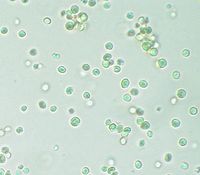
Photo from wikipedia
Microalga is known to grow at high rates and thrive in the non-arable land. It is also the most favorable feedstock for an affordable and sustainable supply of food and… Click to show full abstract
Microalga is known to grow at high rates and thrive in the non-arable land. It is also the most favorable feedstock for an affordable and sustainable supply of food and oil which can produce significant oil yield in less area. Its oil is considered as functional oil with great commercial potential, rich in beneficial fatty acids composition. Data from archaeological discoveries indicate that humans have developed on a diet that had a ratio of about 1/1 of omega-6, (ω-6) to omega-3, (ω-3) fatty acids. Western and Malaysian diets are deficient in ω-3 as both have greater ω-6/ ω-3 ratio. In this study, Nannochloropsis oculata, (N. oculata) is used as an alternative source for edible oil application and the lipids are extracted via both conventional extraction (CE) and microwave-assisted extraction (MWE). The lipid yield was determined by the gravimetric technique and GC-FID was used to identify the fatty acid methyl ester profiles. Findings revealed the CE technique is more appropriate to be used when extracting lipids from N. oculata for edible oil production. Both techniques are successful in extracting the two most important types of fatty acids (C16 and C18). The lipids produced also comprise of specific valuable fatty acids such as arachidonic acid (ARA) and eicosapentaenoic acid (EPA) but do not produce trans-fatty acid. This edible oil obtained has a healthier ratio (~ 1) of ω-6/ ω-3 for the human diet. Thus, N. oculata has the potential to be used as a source of edible oil.
Journal Title: Food Science and Technology International
Year Published: 2020
Link to full text (if available)
Share on Social Media: Sign Up to like & get
recommendations!